Measurements of $CP$ asymmetries in charmless four-body $\Lambda^0_b$ and $\Xi_b^0$ decays
[to restricted-access page]Information
LHCb-PAPER-2018-044
CERN-EP-2019-013
arXiv:1903.06792 [PDF]
(Submitted on 15 Mar 2019)
Eur. Phys. J. C79 (2019) 745
Inspire 1725467
Tools
Abstract
A search for $CP$ violation in charmless four-body decays of $\Lambda_b$ and $\Xi_b^0$ baryons with a proton and three charged mesons in the final state is performed. To cancel out production and detection charge-asymmetry effects, the search is carried out by measuring the difference between the $CP$ asymmetries in a charmless decay and in a decay with an intermediate charmed baryon with the same particles in the final state. The data sample used was recorded in 2011 and 2012 with the LHCb detector and corresponds to an integrated luminosity of $3 {\rm fb}^{-1}$. A total of 18 $CP$ asymmetries are considered, either accounting for the full phase space of the decays or exploring specific regions of the decay kinematics. No significant $CP$-violation effect is observed in any of the measurements.
Figures and captions
|
Distributions of invariant masses of pairs of final-state particles for the candidates selected in the mass window of $\pm 3\sigma$ around the measured $\Lambda ^0_ b $ mass. Figures (a), (b) and (c) show the two-body invariant-mass distributions of baryonic $p\pi^-$, $p\pi^+$ pairs from $\Lambda ^0_ b \rightarrow p K ^-\pi ^+\pi ^-$ decays and $pK^-$ pairs from $\Lambda ^0_ b \rightarrow p K ^- K ^+ K ^-$ decays, respectively. Structures around known the masses of the $N(1520)$, $\Delta(1232)^{++}$ and $\Lambda(1520)$ baryons are observed. Figures (d), (e) and (f) show the invariant-mass distributions of $K^-\pi^+$, $K^-K^+$ and $\pi^+\pi^-$ pairs from $\Lambda ^0_ b \rightarrow p K ^-\pi ^+\pi ^-$ , $\Lambda ^0_ b \rightarrow p K ^- K ^+ K ^-$ and $\Lambda ^0_ b \rightarrow p \pi ^-\pi ^+\pi ^-$ decays, respectively. Structures corresponding to the $K^*(892)^0$, $\phi $ and $\rho (770)^0 $ resonances are visible. The red lines correspond to the invariant-mass requirements applied to the selection of the main quasi-two- or three-body decays analysed. |
Fig1a.pdf [18 KiB] HiDef png [151 KiB] Thumbnail [160 KiB] *.C file |

|
|
Fig1b.pdf [16 KiB] HiDef png [146 KiB] Thumbnail [148 KiB] *.C file |

|
|
|
Fig1c.pdf [16 KiB] HiDef png [141 KiB] Thumbnail [143 KiB] *.C file |

|
|
|
Fig1d.pdf [16 KiB] HiDef png [162 KiB] Thumbnail [163 KiB] *.C file |
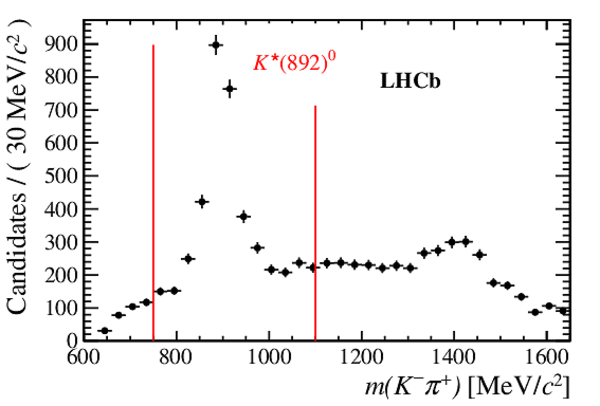
|
|
|
Fig1e.pdf [15 KiB] HiDef png [138 KiB] Thumbnail [128 KiB] *.C file |
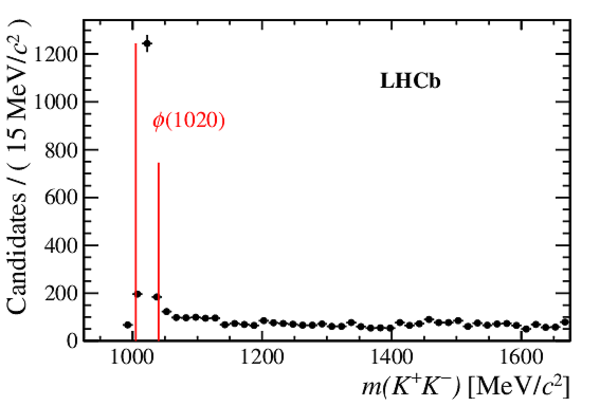
|
|
|
Fig1f.pdf [17 KiB] HiDef png [148 KiB] Thumbnail [155 KiB] *.C file |

|
|
|
Invariant $ p \pi ^-\pi ^+\pi ^-$ mass distributions with the results of the fit superimposed: (first row) full phase space, (second row) LBM and (third row) $\Lambda ^0_ b \rightarrow (\Lambda ^+_ c \rightarrow p \pi ^-\pi ^+)\pi ^-$ control channel. The two columns correspond to the charge-conjugate final states: (left) baryon, (right) antibaryon. The different components employed in the fit model are indicated in the legends. The $\Lambda ^0_ b \rightarrow $ five-body legend includes two components: the partially reconstructed $\Lambda ^0_ b \rightarrow p \pi ^-\eta ^{\prime} $ and $\Lambda ^0_ b \rightarrow p \pi ^-\pi ^+\pi ^-\pi ^0$ decays where a $\gamma$ or $\pi^0$ is not reconstructed. The latter has a lower-mass endpoint. |
Fig2a.pdf [34 KiB] HiDef png [326 KiB] Thumbnail [250 KiB] *.C file |

|
|
Fig2b.pdf [33 KiB] HiDef png [262 KiB] Thumbnail [191 KiB] *.C file |
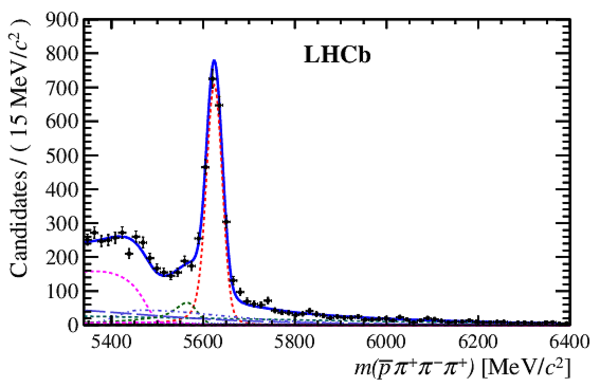
|
|
|
Fig2c.pdf [33 KiB] HiDef png [322 KiB] Thumbnail [250 KiB] *.C file |

|
|
|
Fig2d.pdf [32 KiB] HiDef png [254 KiB] Thumbnail [189 KiB] *.C file |
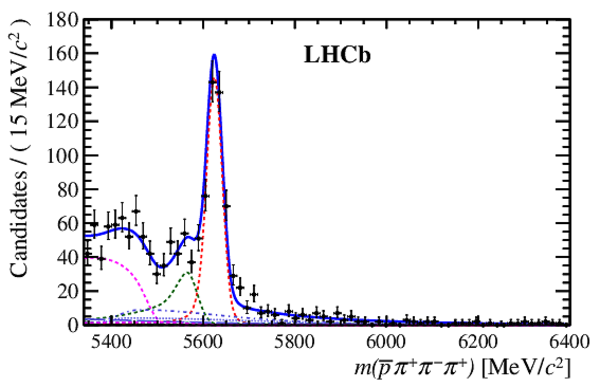
|
|
|
Fig2e.pdf [27 KiB] HiDef png [200 KiB] Thumbnail [162 KiB] *.C file |

|
|
|
Fig2f.pdf [27 KiB] HiDef png [179 KiB] Thumbnail [142 KiB] *.C file |

|
|
|
Invariant $ p \pi ^-\pi ^+\pi ^-$ mass distributions with the results of the fit superimposed: region of the phase space containing (first row) $\Lambda ^0_ b \rightarrow p a_{1} (1260)^-$ , (second row) $\Lambda ^0_ b \rightarrow \Delta(1232)^{++}\pi ^{-}\pi ^{-}$ and (third row) $\Lambda ^0_ b \rightarrow N(1520)^0\rho (770)^0 $ quasi two-body decays. The two columns correspond to the charge-conjugate final states: (left) baryon, (right) antibaryon. The different components employed in the fit model are indicated in the legends. The $\Lambda ^0_ b \rightarrow $ five-body legend includes two components: the partially reconstructed $\Lambda ^0_ b \rightarrow p \pi ^-\eta ^{\prime} $ and $\Lambda ^0_ b \rightarrow p \pi ^-\pi ^+\pi ^-\pi ^0$ decays where a $\gamma$ or $\pi^0$ is not reconstructed. The latter has a lower-mass endpoint. |
Fig3a.pdf [32 KiB] HiDef png [292 KiB] Thumbnail [229 KiB] *.C file |

|
|
Fig3b.pdf [31 KiB] HiDef png [233 KiB] Thumbnail [172 KiB] *.C file |
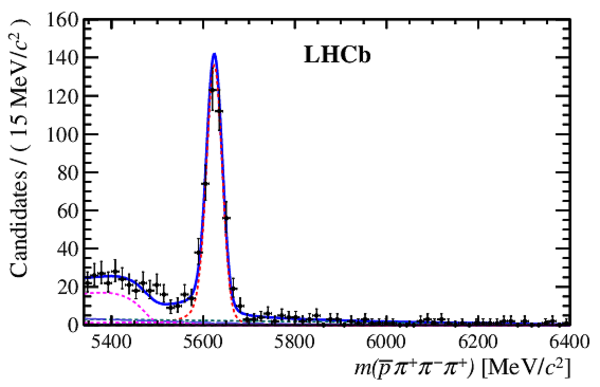
|
|
|
Fig3c.pdf [31 KiB] HiDef png [265 KiB] Thumbnail [216 KiB] *.C file |

|
|
|
Fig3d.pdf [30 KiB] HiDef png [206 KiB] Thumbnail [158 KiB] *.C file |

|
|
|
Fig3e.pdf [32 KiB] HiDef png [305 KiB] Thumbnail [244 KiB] *.C file |

|
|
|
Fig3f.pdf [31 KiB] HiDef png [245 KiB] Thumbnail [189 KiB] *.C file |
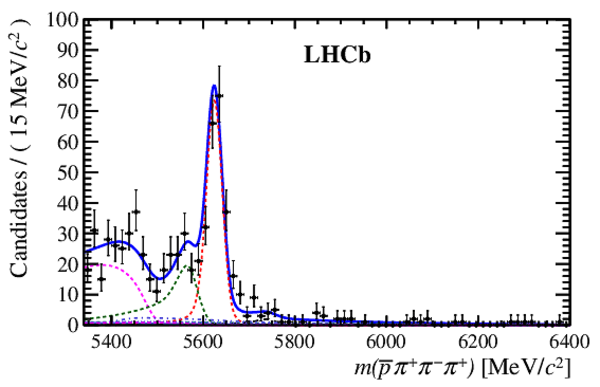
|
|
|
Invariant $ p K ^-\pi ^+\pi ^-$ mass distributions with the results of the fit superimposed: (first row) full phase space, (second row) LBM and (third row) $\Lambda ^0_ b \rightarrow (\Lambda ^+_ c \rightarrow p K ^-\pi ^+)\pi ^-$ control channel. The two columns correspond to the charge-conjugate final states: (left) baryon, (right) antibaryon. The different components employed in the fit are indicated in the legends. The $\Lambda ^0_ b \rightarrow $ five-body legend includes two components: the partially reconstructed $\Lambda ^0_ b \rightarrow p K ^-\eta ^{\prime} $ and $\Lambda ^0_ b \rightarrow p K ^-\pi ^+\pi ^-\pi ^0$ decays where a $\gamma$ or $\pi^0$ is not reconstructed. The latter has a lower-mass endpoint. |
Fig4a.pdf [35 KiB] HiDef png [320 KiB] Thumbnail [241 KiB] *.C file |
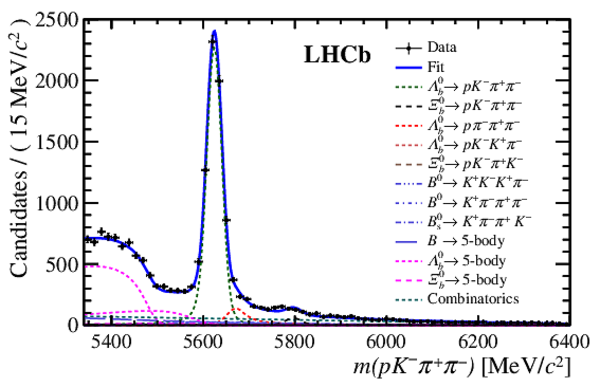
|
|
Fig4b.pdf [34 KiB] HiDef png [240 KiB] Thumbnail [168 KiB] *.C file |

|
|
|
Fig4c.pdf [34 KiB] HiDef png [288 KiB] Thumbnail [227 KiB] *.C file |
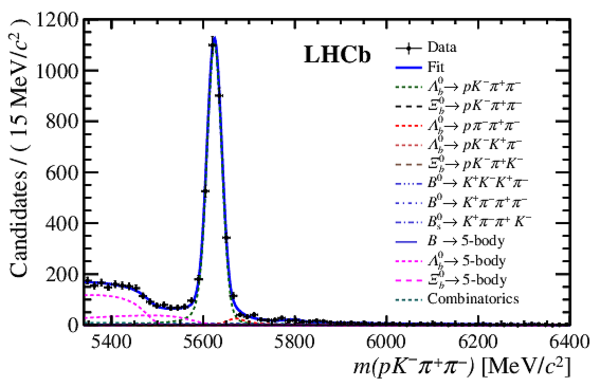
|
|
|
Fig4d.pdf [33 KiB] HiDef png [208 KiB] Thumbnail [153 KiB] *.C file |
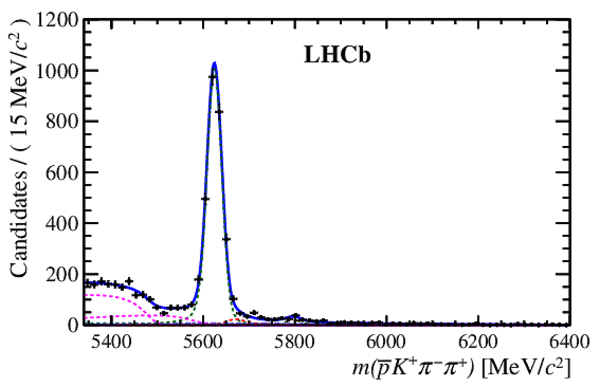
|
|
|
Fig4e.pdf [29 KiB] HiDef png [232 KiB] Thumbnail [192 KiB] *.C file |

|
|
|
Fig4f.pdf [28 KiB] HiDef png [204 KiB] Thumbnail [165 KiB] *.C file |

|
|
|
Invariant $ p K ^-\pi ^+\pi ^-$ distributions, with the results of the fit superimposed: region of the phase space containing (first row) $\Lambda ^0_ b \rightarrow p K_{1} (1410)^-$ , (second row) $\Lambda ^0_ b \rightarrow \Delta(1232)^{++} K ^{-}\pi ^{-}$ , (third row) $\Lambda ^0_ b \rightarrow \Lambda(1520)\rho (770)^0 $ and (last row) $\Lambda ^0_ b \rightarrow N(1520)^0 K ^*(892)^{0} $ quasi two-body decays. The two columns correspond to the charge-conjugate final states: (left) baryon, (right) antibaryon. The different components employed in the fit are indicated in the legends. |
Fig5a.pdf [33 KiB] HiDef png [303 KiB] Thumbnail [243 KiB] *.C file |
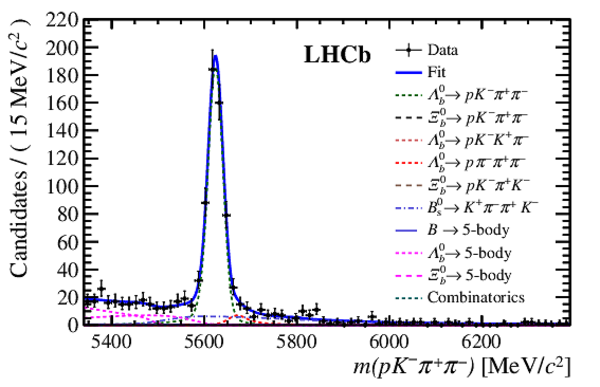
|
|
Fig5b.pdf [31 KiB] HiDef png [231 KiB] Thumbnail [176 KiB] *.C file |
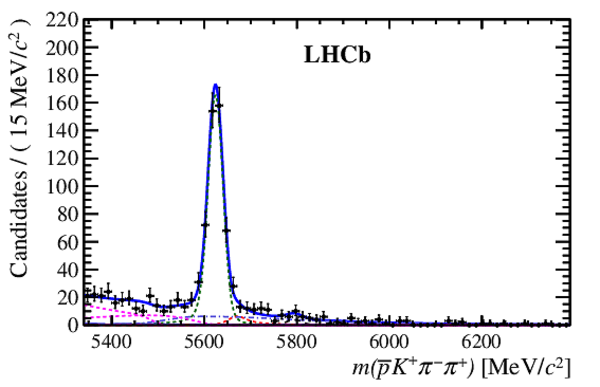
|
|
|
Fig5c.pdf [35 KiB] HiDef png [328 KiB] Thumbnail [255 KiB] *.C file |
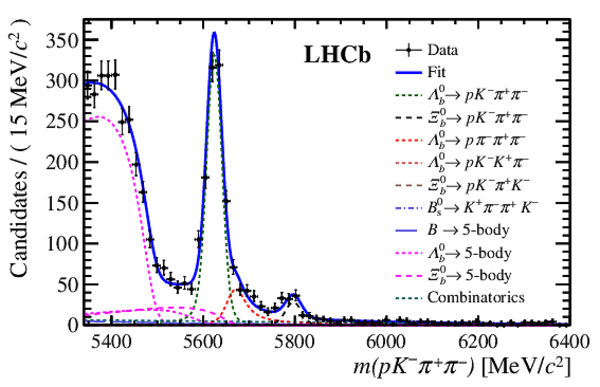
|
|
|
Fig5d.pdf [33 KiB] HiDef png [257 KiB] Thumbnail [187 KiB] *.C file |
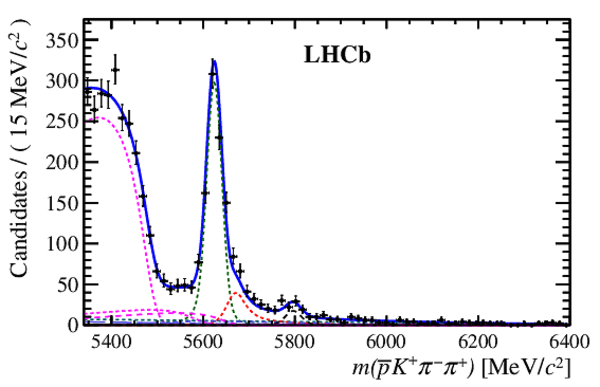
|
|
|
Fig5e.pdf [30 KiB] HiDef png [262 KiB] Thumbnail [208 KiB] *.C file |

|
|
|
Fig5f.pdf [29 KiB] HiDef png [215 KiB] Thumbnail [166 KiB] *.C file |

|
|
|
Fig5g.pdf [31 KiB] HiDef png [259 KiB] Thumbnail [207 KiB] *.C file |
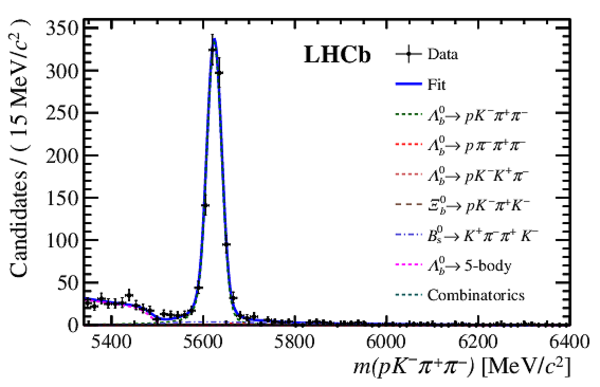
|
|
|
Fig5h.pdf [30 KiB] HiDef png [203 KiB] Thumbnail [156 KiB] *.C file |
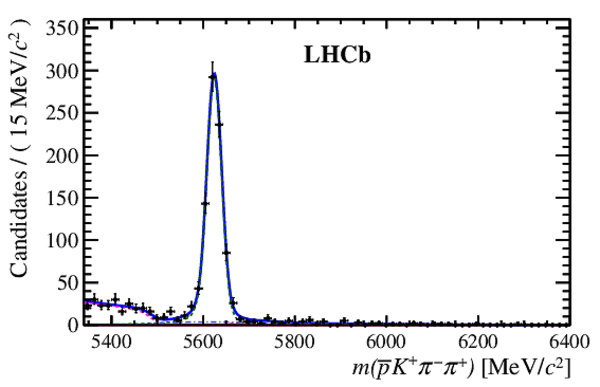
|
|
|
Invariant $ p K ^- K ^+ K ^-$ mass distributions, with the results of the fit superimposed: (first row) full phase space and (second row) LBM, (third row) $\Lambda ^0_ b \rightarrow \Lambda(1520)\phi $ and (fourth row) $\Lambda ^0_ b \rightarrow ( p K ^{-})_\text{ high-mass} \phi $ . The two columns correspond to the charge-conjugate final states: (left) baryon, (right) antibaryon. The different components employed in the fit are indicated in the legends. The $\Lambda ^0_ b \rightarrow $ five-body legends includes two decays: partially reconstructed $\Lambda ^0_ b \rightarrow p K ^- K ^+ K ^-\gamma $ and $\Lambda ^0_ b \rightarrow p K ^- K ^+ K ^-\pi ^0$ , where the $\gamma $ and $\pi^0$ are not reconstructed. |
Fig6a.pdf [35 KiB] HiDef png [347 KiB] Thumbnail [264 KiB] *.C file |
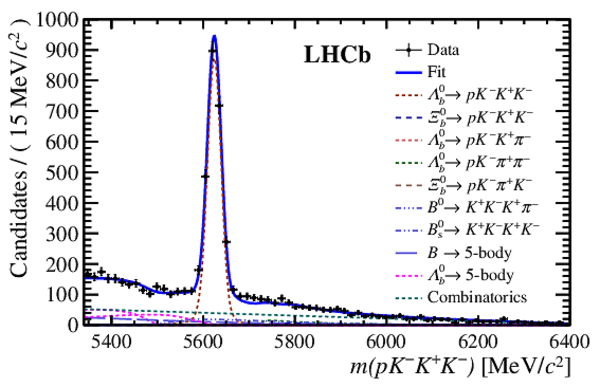
|
|
Fig6b.pdf [34 KiB] HiDef png [272 KiB] Thumbnail [196 KiB] *.C file |

|
|
|
Fig6c.pdf [32 KiB] HiDef png [289 KiB] Thumbnail [221 KiB] *.C file |
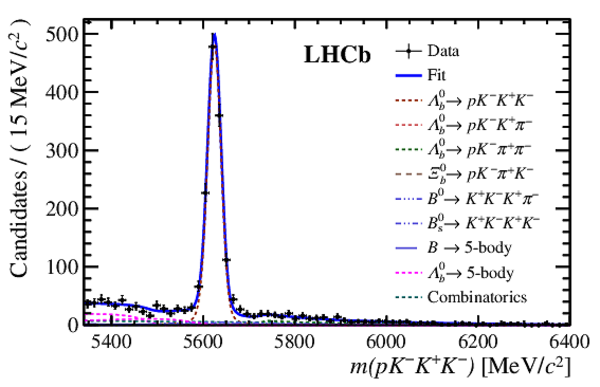
|
|
|
Fig6d.pdf [31 KiB] HiDef png [216 KiB] Thumbnail [155 KiB] *.C file |
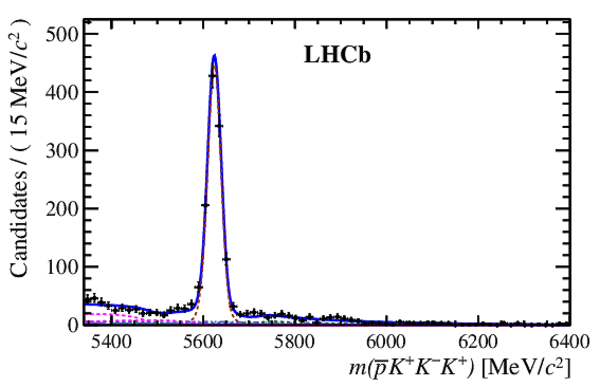
|
|
|
Fig6e.pdf [23 KiB] HiDef png [228 KiB] Thumbnail [183 KiB] *.C file |
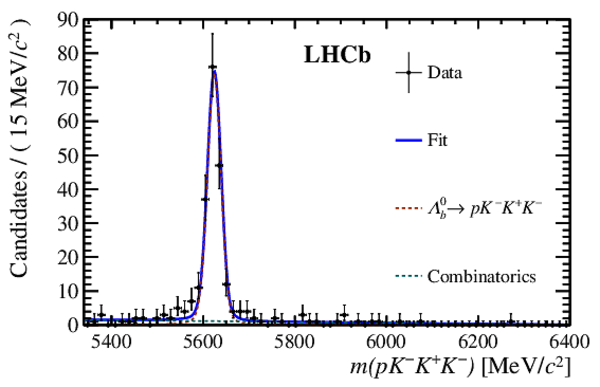
|
|
|
Fig6f.pdf [26 KiB] HiDef png [204 KiB] Thumbnail [161 KiB] *.C file |

|
|
|
Fig6g.pdf [31 KiB] HiDef png [292 KiB] Thumbnail [225 KiB] *.C file |

|
|
|
Fig6h.pdf [31 KiB] HiDef png [246 KiB] Thumbnail [182 KiB] *.C file |

|
|
|
Invariant (first row) $ p K ^- K ^+\pi ^-$ and (second row) $ p K ^-\pi ^+ K ^-$ mass distributions, with the results of the fit superimposed. The two bottom plots are the results of the fit to the $\Xi ^0_ b \rightarrow (\Xi ^+_ c \rightarrow p K ^-\pi ^+)\pi ^-$ control channel. The two columns correspond to the charge-conjugate final states: (left) baryon, (right) antibaryon. The different components employed in the fit are indicated in the legends. The $\Lambda ^0_ b \rightarrow $ five-body legend includes two components where a $\pi^0$ is not reconstructed: the partially reconstructed background $\Lambda ^0_ b \rightarrow p K ^-\pi ^+\pi ^-\pi ^0$ where a pion is misidentified as a kaon and the partially reconstructed background $\Lambda ^0_ b \rightarrow p K ^- K ^+\pi ^-\pi ^0$ . |
Fig7a.pdf [36 KiB] HiDef png [387 KiB] Thumbnail [295 KiB] *.C file |

|
|
Fig7b.pdf [35 KiB] HiDef png [320 KiB] Thumbnail [232 KiB] *.C file |
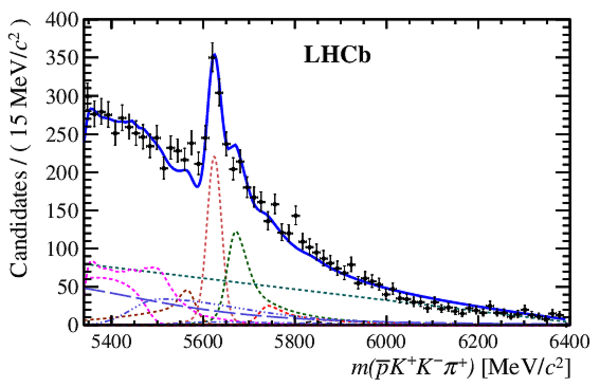
|
|
|
Fig7c.pdf [34 KiB] HiDef png [390 KiB] Thumbnail [299 KiB] *.C file |

|
|
|
Fig7d.pdf [33 KiB] HiDef png [322 KiB] Thumbnail [235 KiB] *.C file |
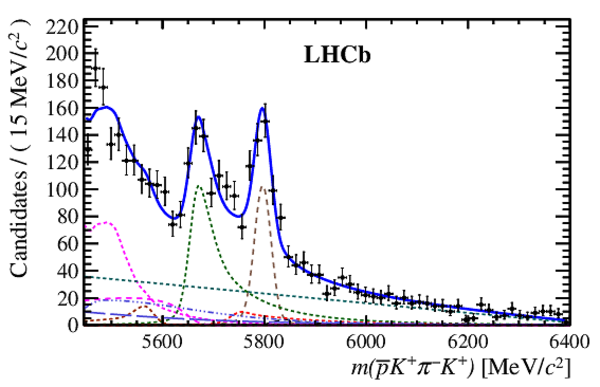
|
|
|
Fig7e.pdf [31 KiB] HiDef png [292 KiB] Thumbnail [233 KiB] *.C file |

|
|
|
Fig7f.pdf [30 KiB] HiDef png [248 KiB] Thumbnail [189 KiB] *.C file |

|
|
|
Animated gif made out of all figures. |
PAPER-2018-044.gif Thumbnail |

|
Tables and captions
|
Four-body charmless and charmed decays considered in this analysis. The difference of $ C P$ -asymmetries measured for the charmless modes and for the control channels results in $\Delta {\mathcal{A}}^{ C P } $ measurements. For each observable, the choice of the control channel is aiming at cancelling at first order production and detection asymmetries. Given the data samples at hand, it is not possible to meet both criteria for the signal decay $\Xi ^0_ b \rightarrow p K ^-\pi ^+ K ^-$ : the choice of the Cabibbo-favoured decay $\Xi ^0_ b \rightarrow (\Xi ^+_ c \rightarrow p K ^-\pi ^+)\pi ^-$ as a control channel requires in turn to correct the corresponding $\Delta {\mathcal{A}}^{ C P } $ for the kaon-detection asymmetry. |
Table_1.pdf [66 KiB] HiDef png [68 KiB] Thumbnail [33 KiB] tex code |

|
|
Invariant-mass requirements applied for the different phase-space selections for each final state considered. |
[Error creating the table] | |
|
Systematic uncertainties for each decay mode. The uncertainties related to the kaon and proton detection asymmetry, the difference of triggering efficiency, the PID asymmetries and the production asymmetry are respectively reported as $\sigma_K$, $\sigma_p$, $\sigma_{\rm L0}$, $\sigma_{\rm PID}$ and $\sigma_{A_P}$. |
[Error creating the table] | |
|
Signal yields for each decay mode, summed over all trigger configurations and years of data taking. |
[Error creating the table] |
Created on 27 April 2024.
